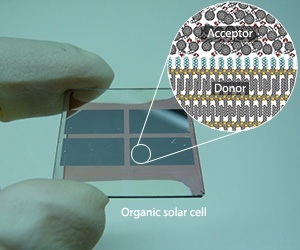| Sep 12, 2011 |
Organic solar cells: One layer at a time
|
|
(Nanowerk News) Solar cells made from organic semiconductors rather than silicon are relatively easy to fabricate but their energy conversion performance has so far been limited due to the typically poor quality of their internal interfaces. The quality of the 'donor–acceptor' junction between the negatively and positively charged regions is particularly important in such devices. Keisuke Tajima and colleagues at the University of Tokyo in Japan and the Beijing Institute of Technology in China have now demonstrated an unprecedented degree of control over this donor–acceptor junction ("Tailoring organic heterojunction interfaces in bilayer polymer photovoltaic devices").
|
 |
| A solar cell made using CFT and a schematic diagram of the high-quality donor–acceptor junction.
|
|
The high internal electric field that arises at the donor–acceptor junction separates the light-generated free charges in the cell and allows them to contribute to the production of an electrical current. If the contact between the two materials that make up the interface is poor, however, these free charges recombine and are lost.
|
|
Tajima and his colleagues used a technique they had previously developed called contact film transfer (CFT) to form their junction. CFT involves making and stacking two separate semiconducting films without high temperatures or pressures, leading to the formation of a flat, well-defined interface.
|
|
The researchers used CFT to fabricate a solar cell using the common organic semiconductors PCBM and P3HT, and found that its performance was comparable to that for a device made using conventional methods. They then added a fluorine-containing monolayer to one of the semiconductors before it was stacked to create an electric dipole (see image). This addition allowed the maximum voltage produced by the solar cell to be tuned by varying the inserted monolayer material without changing the combination of bulk materials. The maximum voltage of 0.95 V achieved by Tajima and his team is also the highest recorded for a PCBM/P3HT-based solar cell.
|
|
The combination of CFT and surface monolayers therefore appears to be an effective means for controlling the physics of charge separation, with application not only in energy conversion but also in more fundamental studies of charge separation processes. A particularly appealing target, says Tajima, is to control the mixed interfaces found inside bulk heterojunction devices, which currently have the best efficiencies of any organic photovoltaics.
|

